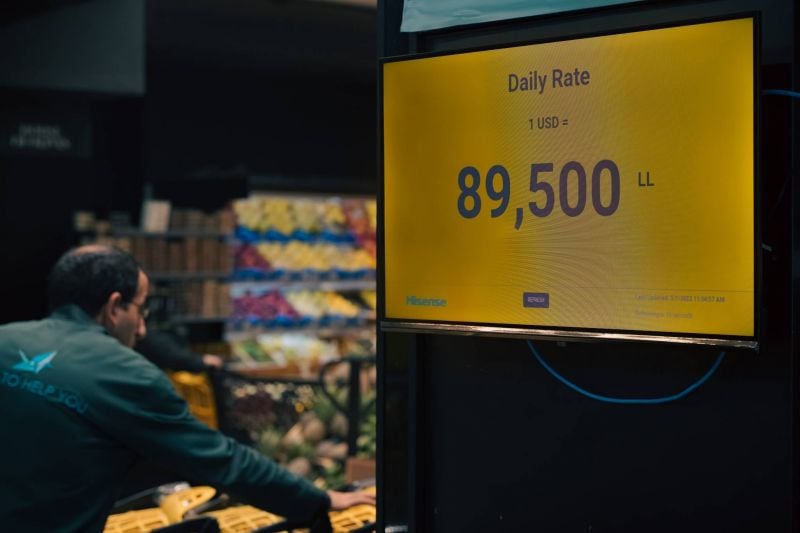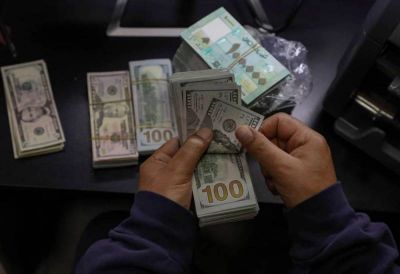
Supermarkets and other businesses are required to display a clear exchange rate, which may vary from day to day, or even hour to hour. (Credit: Mohammad Yassine)
“It is shameful and unfair,” said Siham, a customer of a large supermarket chain in Ashrafieh’s Sassine Square inBeirut. “The people can’t do anything about it and they are the ones suffering. All we have left is God, all politicians are traitors and miscreants.”
On March 1, Siham did not buy any products with prices displayed in dollars, purchasing only products still priced in Lebanese lira.
“Our country is lost. Good people are six feet under. We can’t make our voices heard,” she said.
Following the Economy Ministry’s decision, shops and supermarkets began displaying their prices in dollars on Wednesday. Customers can still pay in lira according to an exchange rate clearly displayed in the shop. The ministry adopted this measure as a means of coping with the rapid depreciation of the national currency.
But consumers have a different take on it.
In supermarkets Wednesday, customers were divided into two categories: those who saw the dollarized prices as an advantage in terms of transparency and those who felt it was the last straw in Lebanon’s acute economic and financial crisis.
A regular customer of a large supermarket in Sassine Square, Michel did not seem panicked, even though his pension — which was worth $900 before the crisis — is now worth less than $50 dollars on the parallel market. Standing in the pasta section, he was impassive.
“It’s not a problem. You can pay in dollars or lira,” he said.
Like every day, he paid in cash with lira, which he had just exchanged with the few hundred dollars his son sends him from abroad every month.
The dollar rate hit a new record high of LL89,500 and was displayed at the entrance of the supermarket.
“It seems that they are taking precautions,” he said. “What can we do, except to follow like sheep?”
‘I don’t get it’
“We have to adapt. Can we change the situation?” asked Maria, a 50-year-old woman whose meager salary makes most of the goods in this supermarket unaffordable. “There are things I don’t buy anymore.”
“[In] dollars or Lebanese lira, it’s the same thing— the prices are very high,” Cosette said, pointing to a jar of labneh that she would have loved to buy.
Mira, an employee of a large British supermarket chain, combed through the shelves to print out the new prices in dollars set by the store.
“It’s going to be difficult ... But this country is like that, we have to keep moving forward,” she said half-heartedly. Mira is still paid in lira.
Some products remain priced in lira. Local goods — such as fruits and vegetables — that do not require the purchase of ingredients from abroad will remain displayed in local currency, said the manager of a Lebanese supermarket chain in Hadath, an eastern suburb of Beirut.
Imported products will be gradually dollarized in the coming days.
“The management is waiting for the different distributors in Lebanon to validate the new prices,” said the manager.
“I don’t understand anything,” said Nour, a customer in her forties standing in front of the scanner set up to convert the price of products labeled in dollars into lira.
According to her, those who withdraw their bank deposits at the LL15,000-to-the-dollar exchange rate (compared to LL89,500 on the parallel market, as of Wednesday) will inevitably lose out on the exchange.
“It’s a problem. Many Lebanese don’t have a fresh dollar income,” she added.
‘We live one day at a time’
In a convenience store in a popular neighborhood between Burj Hammoud and Sin al-Fil, prices are always displayed in Lebanese lira in the morning. Known for prices that are well below the market, this small shop is never empty.
“Depending on the dollar's exchange rate on the market, prices fluctuate,” said the manager of the shop, who did not want to be named.
“[The price of] this cheese has gone up LL10,000 compared to yesterday,” said a loyal customer after scanning the item on the newly-installed machine.
The shop next door also has not yet priced its products in dollars.
“We increase the prices to the extent possible in line with the market,” said the owner. “To feed my family, I need four bread bundles per day, not to mention the rest,” said Souad, a customer. “Given the permanent inflation, we live one day at a time.”
In this supermarket in the southern suburb, known for its advantageous prices, dollarization is not synonymous with price hikes for the moment, to the great satisfaction of customers. The prices of the many local products are still displayed in lira.
A different pace in different regions
In the Bekaa, only a few supermarkets have implemented the dollarization measure so far.
Only one small shop in Zahle contacted by our correspondent is already displaying prices in dollars. The situation is not much different for supermarkets, since they say they do not have all the tools necessary to execute the change.
One supermarket in Jub Jennin said it needs a little more time. Another large store in the Bekaa preferred not to open its doors Wednesday, in preparation for the shift.
Rabih, a 40-year-old teacher, finds the display of prices in dollars advantageous.
“All supermarkets will have to adopt the same prices, and the differences between shops will be smaller,” he said, noting that he would rather carry a small wad of dollars than huge packages of lira.
Another teacher, Faten — despite being paid in lira like all teachers — acknowledged that this measure will prevent shopkeepers from calculating prices at the rate they want.
In Saida, the various shops are gradually making the transition to dollarized pricing, reported our correspondent in the region. One customer, Mona, said she feels “secure” with the new system.
“I can finally know the real price of each item and compare prices between one shop and another. Previously, the system was more opaque,” she said.
A grocery store owner in Saida said they believe dollarization will preserve the rights of traders, because it prevents the constant jolts of the exchange rate on the parallel market.
This article was originally published in French in L'Orient-Le Jour. Translation by Joelle El Khoury.

